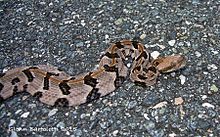Our website is made possible by displaying online advertisements to our visitors.
Please consider supporting us by disabling your ad blocker.
Timber rattlesnake
| Timber rattlesnake | |
|---|---|

| |
| A wild C. horridus encountered within Cooper's Rock State Forest, West Virginia, United States. | |
| Scientific classification | |
| Domain: | Eukaryota |
| Kingdom: | Animalia |
| Phylum: | Chordata |
| Class: | Reptilia |
| Order: | Squamata |
| Suborder: | Serpentes |
| Family: | Viperidae |
| Genus: | Crotalus |
| Species: | C. horridus
|
| Binomial name | |
| Crotalus horridus | |

| |
| Timber rattlesnake range[4] | |
| Synonyms[5] | |
|
List
| |



The timber rattlesnake, canebrake rattlesnake, or banded rattlesnake (Crotalus horridus)[6] is a species of pit viper endemic to eastern North America. Like all other pit vipers, it is venomous, with a very toxic bite.[7] C. horridus is the only rattlesnake species in most of the populous Northeastern United States and is second only to its relatives to the west, the prairie rattlesnake, as the most northerly distributed venomous snake in North America.[8][9] No subspecies are currently recognized.[10][11]
- ^ Parmley, Dennis (1995). "Hemphillian (Late Miocene) snakes from Nebraska, with comments on Arikareean through Blancan snakes of midcontinental North America". Journal of Vertebrate Paleontology. 15 (1): 79–95. Bibcode:1995JVPal..15...79P. doi:10.1080/02724634.1995.10011208. S2CID 129349031.
- ^ Hammerson, G.A. (2007). "Crotalus horridus". IUCN Red List of Threatened Species. 2007: e.T64318A12765920. doi:10.2305/IUCN.UK.2007.RLTS.T64318A12765920.en. Retrieved 9 November 2022.
- ^ NatureServe (2 June 2023). "Crotalus horridus". NatureServe Network Biodiversity Location Data accessed through NatureServe Explorer. Arlington, Virginia: NatureServe. Retrieved 25 June 2023.
- ^ U.S. Geological Survey (2017). "Timber Rattlesnake (Crotalus horridus) rTIRAx_CONUS_2001v1 Range Map". Gap Analysis Project. doi:10.5066/F7BR8R5P.
- ^ McDiarmid RW, Campbell JA, Touré TA (1999). Snake Species of the World: A Taxonomic and Geographic Reference, Volume 1. Washington, District of Columbia: Herpetologists' League. ISBN 1-893777-00-6 (series). ISBN 1-893777-01-4 (volume).
- ^ Wright AH, Wright AA (1957). Handbook of Snakes of the United States and Canada. Ithaca and London: Comstock Publishing Associates, a division of Cornell University Press. (7th printing, 1985). 1,105 pp. (in two volumes). ISBN 0-8014-0463-0. (Crotalus horridus, pp. 956–966.)
- ^ Rokyta, Darin R.; Wray, Kenneth P.; Margres, Mark J. (2013). "The genesis of an exceptionally lethal venom in the timber rattlesnake (Crotalus horridus) revealed through comparative venom-gland transcriptomics". BMC Genomics. 14: 394. doi:10.1186/1471-2164-14-394. PMC 3701607. PMID 23758969.
- ^ Conant R (1975). A Field Guide to Reptiles and Amphibians of Eastern and Central North America, Second Edition. (First published in 1958). Boston: Houghton Mifflin Company. xviii + 429 pp. + Plates 1-48. ISBN 0-395-19979-4 (hardcover), ISBN 0-395-19977-8 (paperback). (Crotalus horridus, pp. 233–235 + Plate 35 + Map 178.)
- ^ Brown, William S. (1991). "Female Reproductive Ecology in a Northern Population of the Timber Rattlesnake, Crotalus horridus ". Herpetologica 47 (1): 101-115.
- ^ Cite error: The named reference
NRDBwas invoked but never defined (see the help page). - ^ "Crotalus horridus ". Integrated Taxonomic Information System. Retrieved 13 March 2023.
Previous Page Next Page




